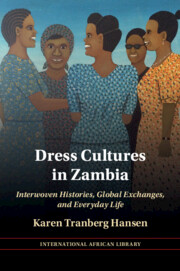Book contents
- Dress Cultures in Zambia
- The International African Library
- Dress Cultures in Zambia
- Copyright page
- Contents
- Figures
- Acknowledgements
- Prologue
- 1 Dress Practice as History
- Part I Dressing Well
- Part II Dress and Undress
- 4 Dress, Undress, Body, and Nation
- 5 Miniskirts and Dangerous Dress Practice
- 6 The Dramaturgy of Body Politics
- Part III Fashionable Transformations
- References
- Index
- Titles in the Series
6 - The Dramaturgy of Body Politics
from Part II - Dress and Undress
Published online by Cambridge University Press: 20 April 2023
- Dress Cultures in Zambia
- The International African Library
- Dress Cultures in Zambia
- Copyright page
- Contents
- Figures
- Acknowledgements
- Prologue
- 1 Dress Practice as History
- Part I Dressing Well
- Part II Dress and Undress
- 4 Dress, Undress, Body, and Nation
- 5 Miniskirts and Dangerous Dress Practice
- 6 The Dramaturgy of Body Politics
- Part III Fashionable Transformations
- References
- Index
- Titles in the Series
Summary
By the time of his indictment for corruption in 2003, former second republican president Frederick Chiluba was already well known as a great dresser. Examining his ostentatious dress practice, the focus turns to the dressed body as a screen for corruption and deceit, exploring when excess considered to be ‘too much’ and why. In his dress style, Chiluba, who presented himself in double-breasted suits and handmade shoes to embody a new era of economic liberalism, provided instant relief from the drabness and austerity of Kaunda’s plain safari suits. When in 2005 several metal trunks and suitcases were discovered in a warehouse in Lusaka, revelations about the former president’s stunning wardrobe attracted sensationalist attention internationally. The revelations were a turning point on which Chiluba’s fondness for spectacular dress morphed into his stored wardrobe and in turn became emblematic of corruption.
- Type
- Chapter
- Information
- Dress Cultures in ZambiaInterwoven Histories, Global Exchanges, and Everyday Life, pp. 99 - 116Publisher: Cambridge University PressPrint publication year: 2023

